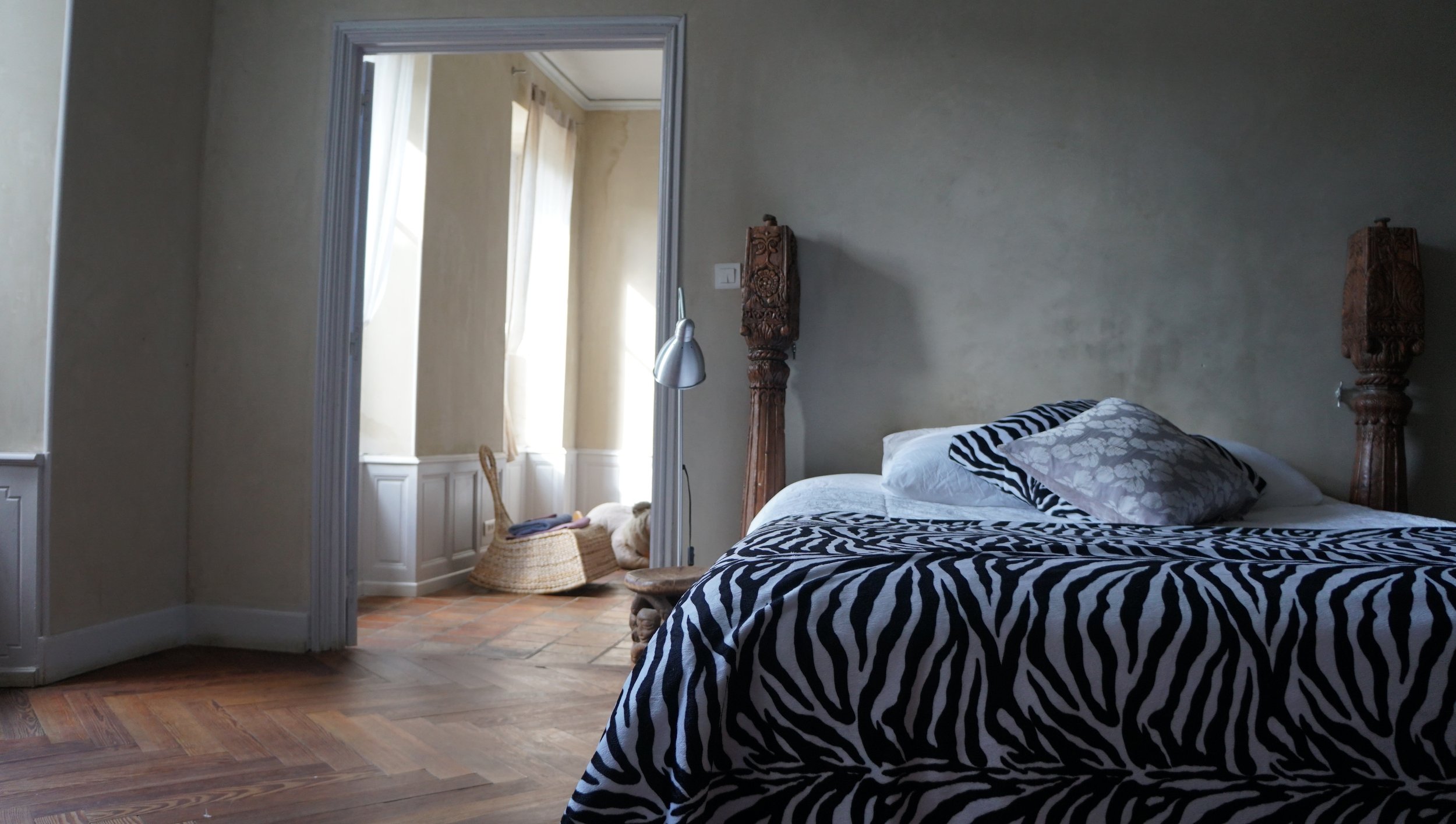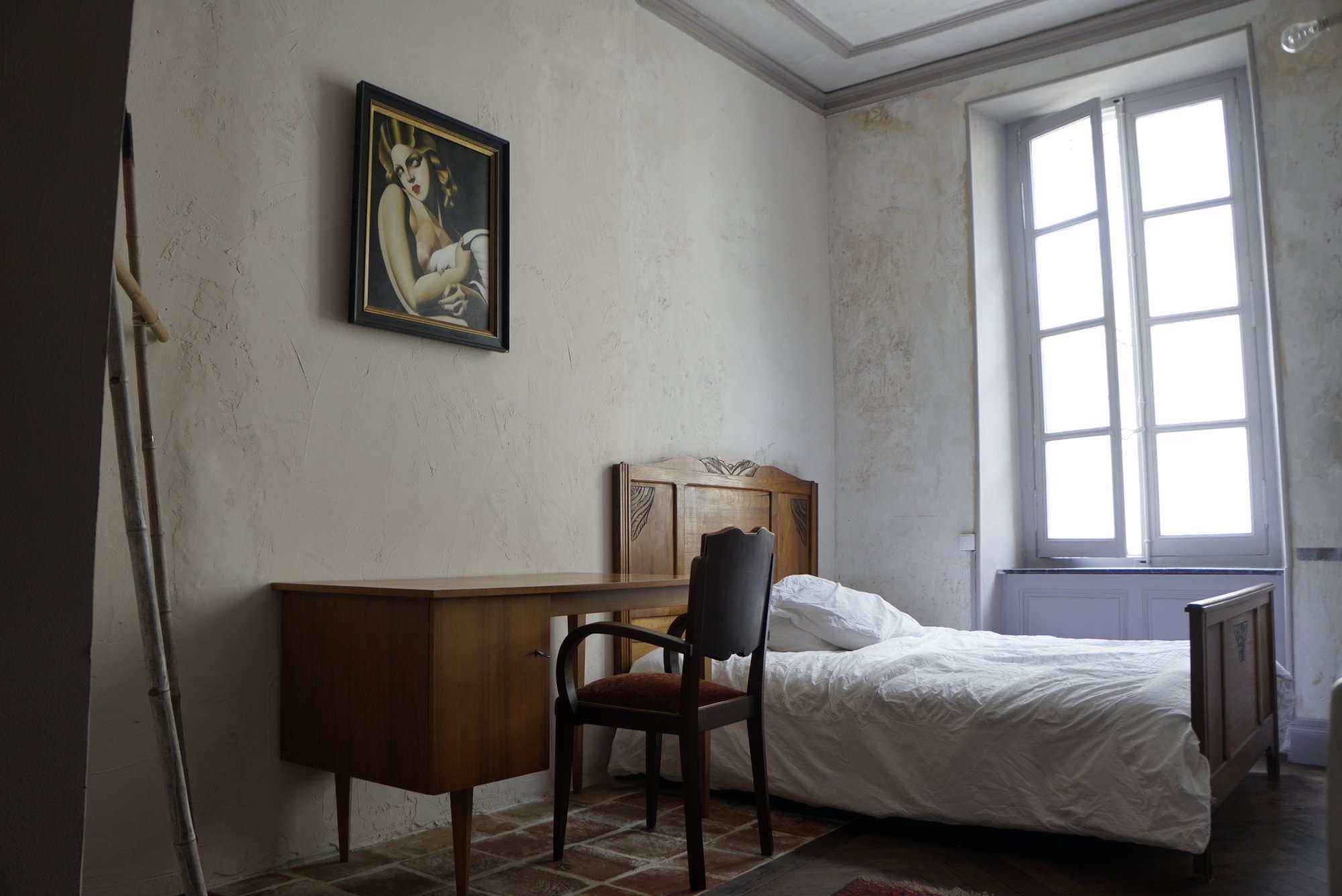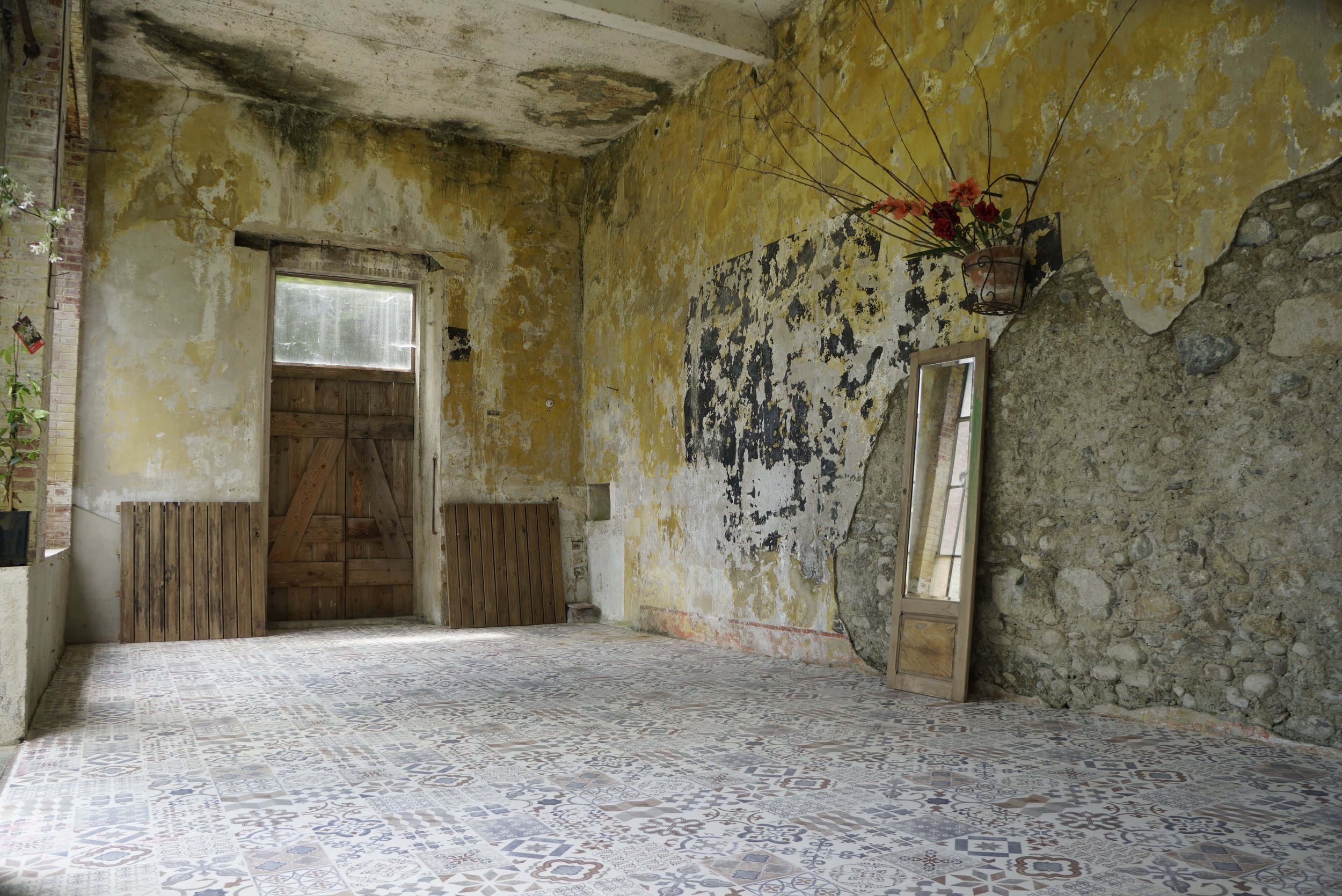An Antidote to Creative Living
Gertrud Keazor is a retired international fencing athlete, massage therapist and Reiki practitioner. When her passion begun to fade for the things that previously brought her joy, Gertrud found purpose in welcoming similarly tired, uninspired souls to her haven in the south of France, where for over a decade, she has offered solace and comfort for those seeking to reignite their fire.
Having found a renewed interest in natural healing arts, Yobaba Lounge has gone from strength to strength, hosted at Gertrud’s village chateau in Chalabre. A place we would most definitely rather be.
Where did the desire for opening up your home to people come from?
I’d been suffering from declining enthusiasm for everything for many years to the point of chronic depression. My best friend, Claire, said, “Gertrud, you need to run yoga retreats!” I didn’t even know what a retreat was, and I disliked the idea of yoga immensely. She said she’d find me a yoga teacher and that all I needed to do was cook. “I hate cooking”, I said. Being so uninspired by everything was my good fortune as I didn’t have the energy to come up with any alternative plans, so I went ahead. Claire helped me find a lovely yoga teacher, and I cooked. And actually, I really enjoyed it. I’m a failed artist, but I found unexpected joy in painting with food for that retreat. The retreatants loved it, and so I carried on.
It is my experience that you can plan yourself out of doing anything. So I just get on with it. After the first retreat, things just unfolded and I just kept going. I was lucky enough to meet the right people and a couple of journalists who attended really loved what I was doing and I got good reviews. The challenge with most businesses is to get it over that initial spurt and build it into something authentic and of value. For me, the most important aspect was to ensure that what I was doing had integrity.
Guests can become quite vulnerable through the retreating process. I had supervision from an ex Buddhist monk for six years who helped me crystallise what I am sharing and who guided me on how to serve and look after my retreat guests. This also helped me on the spiritual journey that was unfolding for me. And without which, in a way, Yobaba Lounge would be nothing.
I have also been lucky with wonderful volunteers and people that have helped me and taught me many important things along the way. But to this day, the business remains a one-woman show. It doesn’t make me rich, but I can live and I enjoy it and I meet amazing people.
Why did you settle on Chalabre as a location?
It’s a cliche; the house chose me. I was looking around, not seriously really, and a friend said come and look at this house in Chalabre. I didn’t really like the house, I had imagined something closer to the coast. For some reason, I made an offer and 6 weeks later I had signed! I have come to love the house, and Chalabre. It is an unspoilt, medieval bastide village where 3 rivers and 5 roads cross. Being in the foothills of the Pyrenees, the region is stunning. It is wild and unkempt and the history is palpable.
Do you feel like you’ve grown into the place?
The core of the house is probably from the 1600s but the parts that give it its architectural character were built just after the French revolution at the end of the 18th century. Until the 1950s it had been the residence of well-to-do merchants and doctors. The last owner from the family, Madame Lafitte, had entertained artists from Paris including Marcel Proust and Gustave Eiffel, who had designed the wrought iron staircase. It was a grand old house, full of light and large spaces. When she died, the house was converted to small bedsits for the workers of the local textile factory. In the 1980s all the textile mills shut down as the industry moved to Asia and so, the region went into decline. The house stood empty until I bought it in 2006, a shadow of its former self; dark, depressed, damaged and sad. The most beautiful thing was the overgrown large garden with the orangery.
“The challenge with most businesses is to get it over that initial spurt and build it into something authentic and of value. For me, the most important aspect was to ensure that what I was doing had integrity.”
I started the renovations with a team of local labourers. I used only natural building materials, I made my own paint with pigments we sourced locally. We removed the walls that were not original and restored the old proportions. We upcycled old sinks, tiles and re-used what we could. As we were working, you could literally feel the house wake up—it became brighter and it participated in the process! For example, I chose the colours that I normally like, but they didn’t work so I ended up with colours unusual for me. But when we started stripping back paint and old wallpapers, those colours matched the original colours of the walls and woodwork.
The house is definitely alive. I feel privileged to have been able to add to the work by the original artisans. Whenever I clear up and renovate a new space, it is definitely a sculpting process. We sculpt a space, not renovate a room.
And your guests, what do they think about the chateaux?
People love the spaciousness of it and its smell. Everyone comments on the smell. They love that it is uncluttered. They say that the house feels like a temple. It is cool in the summer heat, it feels like a sanctuary when you walk in from the busy street. Everything is very tactile. Nothing is covered in modern, plastic paints. I also think that people respond to the proportions of the rooms—the architecture is classical, masonic, using the golden ratio to beautiful effect.
Someone said to me the other day—we don’t buy “things”, we buy “vibrations”. That is so true, everything in the house has a purpose and all the things probably have a similar vibration, because I’ve chosen every single little piece.
So the house sings its song, a symphony in tune and of calm. The house has a soul. People sense it.
The grounds also play a big part in your retreats…
The yoga practice I share here is one that explores the nature of reality, the spectrum of consciousness and matter, and also the continuum of space. How our inner space feels, the physical sensations in our body, the textures of our mind, our emotions. Our awareness and our body goes beyond our skin. We radiate out. We fill a space. In turn, we are also affected by space. It is important to me that the house, the rooms, the yoga shala, the food, the garden, all contribute to the experience of exploring our nature from the more solid to the most subtle of aspects, from our inner space to way out beyond our skin.
The house and the energy curated in it, hold us like a mother. All elements contribute to and amplify the experience for the guests.
“In the 1980s all the textile mills shut down as the industry moved to Asia and so, the region went into decline. The house stood empty until I bought it in 2006, a shadow of its former self; dark, depressed,
damaged and sad.”
How do you strike a balance between your practice and the heritage of your surroundings?
I came to yoga with a “beginner’s mind”. I had attended only a few classes, but circumstances conspired to me doing a daily self-practice. After a while I realised that I wanted to explore this unfettered practice that was arising in me, and I made a conscious decision not to take a modern lineage based yoga teacher training.
The result is that my yoga and mindfulness practice turns out to be in the form of the earliest recorded form of yoga: the Sramana (meaning “seeker”) movement in India (800-600 BC) was using yogic somatic mindfulness practices to seek the truth, to explore the nature of reality. It was a non-theistic tradition. Out of that movement which was distinctly non-vedic, Buddhism, Jainism, and other philosophies arose.
I also recognise universal truths in the Tantric traditions of India and I enjoy studying this. The irony is that my yoga practice and studies of these Indian philosophies and traditions led me to fully embrace my Catholic background and the long deep Christian roots particularly in this region. I feel that all of them share exactly the same fundamental truths: love deeply, do no harm.
You once said, “when your heart no longer feels and your soul is bone tired, you need to come on retreat with us”. How do you ease an exhausted person into retreat life?
The most effective way to ease a person into a retreat is to have a strong, clear structure. It allows people to relax and surrender to the process. We take care of all the practical things like time keeping and food and we guide your practice.
Guests complete a questionnaire which gives me a sense of any physical or emotional/mental weaknesses. During the retreat I also make sure that I allow people their own journey. My responsibility is to provide a clean, safe environment of physical and energetic beauty to hold the structure with kindness and compassion. The guests are responsible for their experience—I don’t shape that experience, but I do lead them on a journey. The retreat team is also guided in what is and what is not their responsibility. Understanding and providing boundaries with compassion is a key component in creating a safe retreat structure.
I do offer a couple of different formats, some are more strongly structured than others. The stronger the structure, the more opportunity for the guest to retreat, to investigate and perhaps transform. The signature retreat is Breathe from the Soul, Yogic Mindfulness in a Modern World. People overwhelmingly feedback transformative experiences. But even the Work Remotely or Self-Retreat format where we only have a simple morning routine and guests do their own thing for the remainder of the day until dinner, people report back paradigm shifts.
Sound and silence play a role in your daily routines at Yobaba. Can you tell us about the practice of Noble Silence?
When staying at the Lounge, you’ll encounter short periods of silence each day. Remaining internal is a really beautiful way to recharge, to spend time with yourself, and to practice clear, compassionate investigation of exactly what our inner voice is saying, how it compels us into “unconscious” action and how it is affecting our outer reality. It forms a key part of any mindfulness practice.
As a rule, we rise in silence and remain so until 8am each day. On some of the retreats, the periods of silence are a little longer, for example on the Breathe from The Soul retreats, we remain silent from after dinner until lunch the next day.
What is the most interesting experience you’ve encountered doing what you now do?
After our second season, I parted ways with the yoga teacher and began my search for another. As I had a very specific idea of what I was looking for, it was proving a little difficult. At the same time, I was also preparing a friend to do the cooking for the season and we decided to do a trial retreat with a group of girl friends, going through all of the meals and cooking them together. For yoga, we just did self-practice.
On the second day, for some reason, I stepped onto the teacher mat and started to guide the yoga sessions. All of our friends on the retreat were accomplished yoginis and yoga teachers, so I don’t know what actually possessed me. In any case, during that trial retreat, I “taught” 10 classes. Each class, I just spoke through the images that came up in my mind,
I didn’t plan anything, I just followed the images and spoke them and guided us through the movements. The sessions were somatic explorations of the philosophies that I later came to recognise in the Tantric and Buddhist traditions. So from somewhere, deep in my DNA, came all this knowledge that I didn’t have before. It was a powerful experience for all of us. As a result of that, I decided to teach the yoga on my retreats and not look for a yoga teacher.
I love that you just went for it and it’s worked out in a way that is meaningful, and so personal for you and your guests. What do you think makes a retreat such a powerful experience for them?
I feel it is powerful because we get a glimpse of our own true nature, we connect to ourselves. Most of us spend our time and effort projecting our “story” outwards for others to verify it back to us. Very few of us manage to just “be”. A retreat lets us feel “soul” arising from ourselves, rather than needing to find it outside from us. This has an incredibly restful and calming effect. It gives us moments of simply being. That’s powerful.
And finally, for those who aren’t able to escape for whatever reason. Are there any elements of retreat life that can be introduced into their daily routine?
Yes, there are definitely things you can do at home. Here are a few suggestions:
1. Give yourself a solid morning routine. Get up at the same time every day. If you can, stay silent until breakfast. Do a morning meditation or yoga practice, even if it is just 10 minutes.
2. Splash your face 7 times with cold water upon waking. It’s an Ayurvedic practice that reduces excess Kapha that collects during the night.
3. Don’t eat breakfast before 10 am
4. Reduce alcohol intake [sorry!]
5. Give yourself time off, so skip the morning routine on weekends for example.







